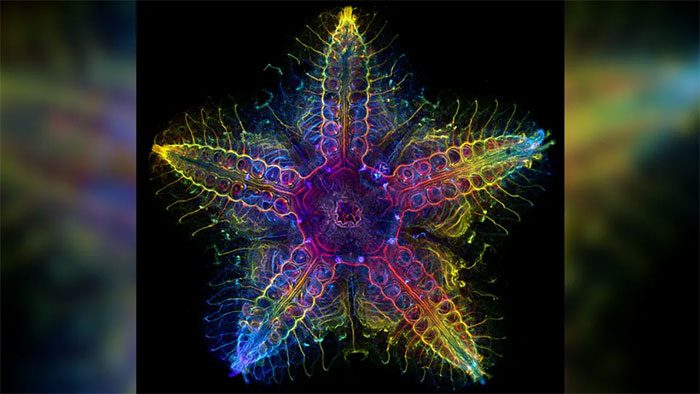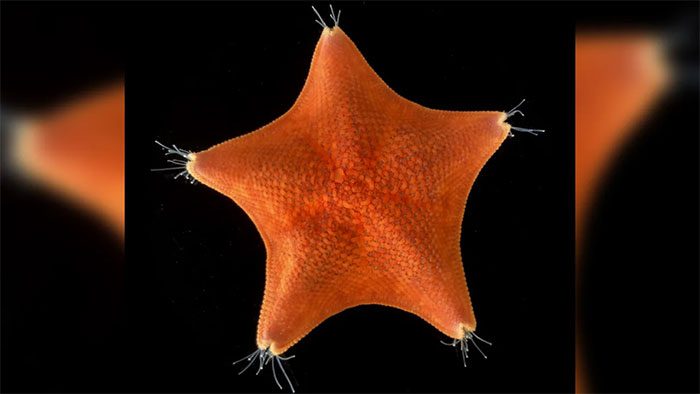To date, scientists have been unable to determine the head of the starfish species.
For most animals, the head can be easily identified. However, scientists have yet to ascertain the same for starfish.
Unique Body Plan

Starfish begin as fertilized eggs, hatching into free-swimming larvae in the ocean, resembling plankton.
A starfish has five identical arms. A layer of “tube feet” underneath helps the marine creature move along the seabed. This shape raises the question among naturalists: do starfish have heads? New genetic research indicates that starfish largely lack heads, bodies, or tails.
It is likely that they lost these characteristics through evolutionary processes over time. Researchers have noted that the peculiar fossils of starfish ancestors seem to possess a type of body structure. This makes much more sense evolutionarily based on the new findings published in the journal Nature.
The lead author of the study, Laurent Formery, a scholar at Stanford University and the University of California, Berkeley, stated: “It’s as if the starfish completely lost a trunk. They are described as merely a head, crawling along the seabed. This is entirely different from what scientists had assumed about this animal after new gene sequencing methods. From this, we may help answer some of the biggest lingering questions about echinoderms, including their common ancestors with humans and other animals.”
Starfish belong to a group known as echinoderms, which includes sea urchins, sand dollars, and sea cucumbers. They have a unique body plan arranged into five equal parts, differing significantly from the bilaterally symmetrical bodies of animals with left and right sides that mirror each other.
Starfish start as fertilized eggs, hatching into free-swimming larvae for weeks to months before settling to the ocean floor. There, they undergo a transformation from a bilateral body plan into a star shape.
Co-author of the study, Christopher Lowe, a marine biologist at Stanford University, noted: “This has been a zoological mystery for centuries. How can you transition from a bilateral body plan to a five-axis plan, and why can any part of the starfish be compared to our own body plan?”
The bilateral body plan that most animals possess arises from genetic activities at the molecular level found in the head and body or regions of the main body.
This is why vertebrates, such as humans and many invertebrates, including insects, share a common genetic program. This discovery was awarded the Nobel Prize in Physiology or Medicine in 1995.
However, echinoderms also share a common ancestor with bilaterally symmetrical animals. This adds to the puzzle that researchers are trying to solve. Co-author of the study, Dr. Jeff Thompson, a lecturer at the University of Southampton, remarked: “Why the different body parts of echinoderms relate to those we see in other animal groups remains a mystery. In bilaterally symmetrical animals, their bodies are divided into head, body, and tail. However, looking only at a starfish, we cannot see how these parts relate to the body of bilateral animals.”

Starfish belong to a group known as echinoderms, which include sea urchins, sand dollars, and sea cucumbers.
Decoding the Mystery
Scientists used computed tomography imaging to capture unprecedented three-dimensional images of the shape and structure of starfish. Subsequently, the research team employed advanced analytical techniques.
This led to the discovery of where genes are expressed in tissues and the identification of specific RNA sequences within cells. Gene expression occurs when the information within a gene becomes functional. Specific molecular signals act like blueprints for the body plan, guiding each cell to the part of the body it belongs to.
Author Lowe stated: “If you peel the skin off an animal and look at the genes related to head and tail determination, these same genes encode for this body region in all animal groups. Thus, we bypassed anatomy and asked: Is there a molecular axis underlying all this strange anatomy, and what role does it play in the starfish’s formation of a five-armed body plan?”
Together, the data created a 3D map to locate the genes expressed as starfish develop and grow. The research team was able to identify the genes controlling the ectoderm development of starfish, including skin and nervous system.
Genetic signals related to head development were discovered throughout starfish, particularly concentrated in the center and each arm. However, gene expression in the body and tail was virtually absent.
This indicates that starfish present the most striking example of the separation between the head and body regions known today. According to the research team, starfish and other echinoderms may have developed unique body structures after their ancestors lost the body region. This allowed them to move and forage differently from other animal species.
According to scientists, studying groups like echinoderms could answer some of the most complex mysteries regarding the evolution of life on Earth. By taking the opportunity to explore these unusual animals that operate in unique ways, scientists will expand their perspectives on biology. This will help address both ecological and biomedical issues.


















































